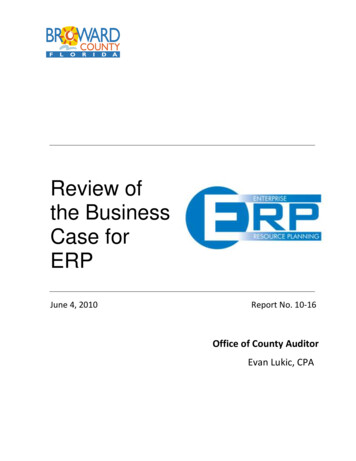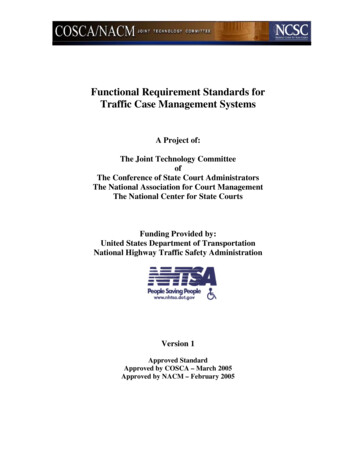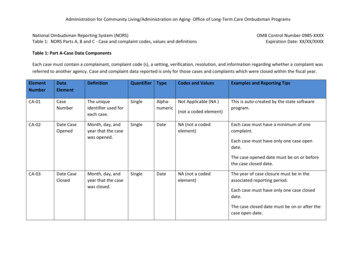
Transcription
Review ofthe BusinessCase forERPJune 4, 2010Report No. 10-16Office of County AuditorEvan Lukic, CPA
Review of the Business Case for ERPExecutive SummaryBroward County has considered the concept of Enterprise Resource Planning (ERP) sinceearly 2007. To evaluate County needs and assess the feasibility of ERP, the Countycommissioned three (3) separate consultant studies that culminated in the Business Case forERP report ͇̯χ͇͋ F̼͋ιϢ̯ιϴ 5 2010 (χ·͋ ͞ ϢνΊΣ͋νν ̯ν͋͟) Based on our review of the Business Case, we determined the following:Many County processes and systems are inefficient, ineffective, and need to be improved.!Σ E· νϴνχ͋ Ίͽ·χ νΪΜϭ͋ νΪ ͋ Ϊ͕ χ·͋ ΪϢΣχϴ͛ν ̽ιΊχΊ̯̽Μ ϢΣ ͋χ Σ͇͋͋ν ̼Ϣχ ζΪν͋ν νΊͽΣΊ͕Ί̯̽Σχrisks without assured results.There appear to be viable, less costly solutions.Accordingly, we recommend the following:1. To ensure the Board members have sufficient information to make an informed decision,we recommend the Board of County Commissioners direct the County Administrator toprovide an analysis of potential solutions to address critical unmet business needs andtechnology issues. The analysis should include priorities, cost estimates, time toimplement, risks and returns.2. To facilitate timely adoption of cost-saving measures, we recommend the Board ofCounty Commissioners direct the County Administrator to begin addressing criticalunmet business needs and technology issues identified in the consultant studies, thatarea. Independent of the ERP decision process, such as implementation of a timeand attendance system, andb. Necessary to ensure the success of our future technology strategy and vision,e.g., business process analysis and re-engineering.The detailed findings and supporting schedules are included in the following pages.Office of the County Auditor1
Review of the Business Case for ERPBackgroundIn 2007, the Government Finance Officers Association (GFOA) performed a TechnologyͲ͇͋͋ν !νν͋νν ͋Σχ νζ͋̽Ί͕Ί̯̽ΜΜϴ ̯Σ ͋ϭ̯ΜϢ̯χΊΪΣ Ϊ͕ ιΪϮ̯ι͇ ΪϢΣχϴ͛ν ͕ΊΣ̯Σ̽Ί̯Μ ̯Σ͇ ·Ϣ ̯Σresources management systems. As a result of study findings, the GFOA recommended thatthe County pursue the implementation of a full Tier I Enterprise Resource Planning (ERP)system, such as Oracle, PeopleSoft, or SAP.According to the GFOA, ERP systemν ̯ι͋ νΪ͕χϮ̯ι͋ ̯ζζΜΊ̯̽χΊΪΣν χ·̯χ νϢζζΪιχ ̯Σ Ϊιͽ̯ΣΊϹ̯χΊΪΣ͛νfinance, human resources, purchasing, and a broad range of other administrative functions.The major advantages of modern ERP systems include the consolidation of data from diversebusiness processes into a single information repository, the incorporation of best practicesand other features that allow organizations to reengineer their business processes forgreater efficiency, and the ability, especially with the addition of business intelligence (BI)capabilities, to disseminate information through all levels of an organization.FΪΜΜΪϮΊΣͽ χ·͋ GF !͛ν Α͋̽·ΣΪΜΪͽϴ Ͳ͇͋͋ν !νν͋νν ͋Σχ χϮΪ ̯͇͇ΊχΊΪΣ̯Μ νχϢ͇Ί͋ν, by SciCom andEquaTerra, Inc., were commissioned to explore the recommended ERP solution. A summaryof the three studies is located at Table 4: Independent Studies of Broward County CurrentState on page 13.Information from the three studies was compiled and presented in the Business Case forEnterprise Resource Planning (ERP) Report, which was sent via transmittal to the Board ofCounty Commissioners from the County Administrator on February 5, 2010.Objective, Scope, and ProceduresOur review was intended to provide the Board of County Commissioners with an objectiveassessment of the ERP Business Case and supporting details.The scope of our review included the studies performed by the GFOA, SciCom, EquaTerra̯Σ͇ χ·͋ !͇ ΊΣΊνχι̯χΊΪΣ͛ν E· ϢνΊΣ͋νν ̯ν͋ ·͋ζΪιχ We reviewed the Business Case and evaluated the three independent studies. Weinterviewed ERP consultants and reviewed methodologies, findings, and recommendationsfrom each study. We analyzed and attempted to validate projections and calculationspresented in each of the studies. We compared the study conclusions with the results of ourown internal reviews of County operations and technology. Finally, we surveyed other localOffice of the County Auditor2
Review of the Business Case for ERPgovernments to obtain additional comparative information and researched details on ERPtechnology and implementation projects.Findings1. Many County processes and systems are inefficient, ineffective, andneed to be improved.The 2007 Technology Assessment performed by the Government Finance OfficersAssociation (GFOA) identified key functional weaknesses and overall deficiencies in Countysystems and processes. Specifically, the GFOA study findings identified:A lack of an overall systems development and integration plan to define how all systemsinterrelate to meet business needs.Inconsistent access to information, a lack of data timeliness and reliability, and inflexiblereporting functions.Redundant data entry and manual processes are required to move data between multiplestandalone systems.A lack of user understanding of available system functionality.Standard financial reports do not meet user needs.Internal decisions to not implement available system functionality have forced theprocurement and development of additional separate, non-interfaced systems.A lack of dedicated oversight and management of system implementations, training, andutilization.Our internal reviews of County programs, processes and technology initiatives generallycorroborate the GFOA͛ν findings.2. An ERP might solve some of the County’s critical unmet needs, butposes significant risks without assured results.The costs, risks and benefits of an ERP project were projected in the GFOA technologyassessment and the subsequent ERP studies. The consultant reports included three commonthemes with an ERP implementation: a) independent business systems will still be required,even with an ERP; b) an ERP implementation project poses significant challenges and risks;and c) ERP technology costs are substantial and returns are not assured.Office of the County Auditor3
Review of the Business Case for ERPa) INDEPENDENT BUSINESS SYSTEMS WILL STILL BE REQUIRED, EVEN WITH AN ERPAn ERP system will not fulfill all of χ·͋ ΪϢΣχϴ͛ν ϢΣ ͋χ ̼ϢνΊΣ͋νν Σ͇͋͋ν ̯Σ͇ ͕ϢΜΜϴ ̽Ϊιι͋̽χprocess and system inefficiencies.The GFOA Technology Needs Assessment suggested that certain process needs might bebetter served by third-party or ̼͞est of ̼ι͇͋͋͟ systems. ! ̼͋͞νχ Ϊ͕ ̼ι͇͋͋͟ ̯ζζιΪ̯̽·allows organizations to choose the best system to meet specific business needs inindividual functional areas.EquaTerra, in developing the scope of an ERP project for the County, also concluded thatcertain independent business systems will remain even with an ERP system. An ERPsystem is not intended to replace critical systems used in operations at Port Everglades,Revenue Collection, Transportation Services, Human Services, Libraries, Parks andRecreation, and for other County agencies and functions. See Tables 1a and 1b:Operational Applications Scheduled/NOT Scheduled for Retirement or Replacement byERP Software on pages 9-10.Some specific functions, such as performance management (PM), will not be provided byERP software. To help determine the impact of an ERP on performance managementprograms, we surveyed 18 local government sites, 12 of which are using tier-1 ERPtechnology. The survey results show that independent PM systems were used in all sites,including those with ERP systems. Budget managers surveyed, including the ·Μ̯͇͋͋ιν͛ ΊΣPM, reported no direct link between their financial systems and their PM programs. SeeTable 2: Survey of Performance Management (PM) Systems for survey results on page 11.b) AN ERP IMPLEMENTATION PROJECT POSES SIGNIFICANT CHALLENGES AND RISKSA 2008 Gartner Group study1 of ERP implementations concluded that ͞ etween 20% and35% of all ERP implementations fail, and up to 80% exceed time and budget estimates.ERP project success requires a focus on people and process, as well as the software.Ignoring these aspects will cause your proΖ͋̽χ χΪ ͕̯ΊΜ ͟·͇͋Ϣ͇̽͋ νχ̯͕͕ΊΣͽ Μ͋ϭ͋Μν ϮΊΜΜ νΊͽΣΊ͕Ί̯̽ΣχΜϴ ̽·̯ΜΜ͋Σͽ͋ χ·͋ ΪϢΣχϴ͛ν ̯̼ΊΜΊχϴ χΪ ͇͇͋Ί̯̽χ͋internal resources to an implementation project. The Business Case for ERP reports over1,300 position reductions have occurred in the past three years, and further cuts areanticipated. Gartner analysis shows that ERP failures are often attributable to1͞!͇͇ι͋νν FΊϭ͋ ͩ͋ϴ F̯̽χΪιν ͕Ϊι Ϣ̽̽͋νν͕ϢΜ E· ͜ ζΜ͋ ͋Σχ̯χΊΪΣν ͟ 29 !ϢͽϢνχ 2008 ·͋ν̯͋ι̽· ͜D ͲϢ ̼͋ι G00160011; 2008 Gartner, Inc. and its affiliates.Office of the County Auditor4
Review of the Business Case for ERPorganizational factors. One Gartner defined prerequisite for success is the full-timeassignment of internal project members with deep business knowledge, and backfillingof those positions for the duration of the ERP project. Based on this research,implementing ERP without a full complement of staff resources diminishes our likelihoodof success.An ERP implementation project will create additional workload for staff, at a time whenCounty resources are shrinking. As a result, the proposed project strategy relies heavilyon third party services to implement and integrate an ERP system, with only limitedassistance from County subject matter experts. Approximately 80%, or 41.3 million, ofestimated project costs are allocated for third party services. D͋χ̯ΊΜν Ϊ͕ EθϢ̯Α͋ιι̯͛νestimated total cost of ownership (TCO) are at Table 3: Estimated Total Cost ofOwnership (TCO) for an ERP Implementation on page 12. Excessive reliance on thirdparty services will:Increase the risk that existing policy and organizational requirements will not be met.D͋̽ι̯͋ν͋ χ·͋ Μ͋ϭ͋Μ Ϊ͕ ζιΪΖ͋̽χ ΪϮΣ͋ιν·Ίζ ̯Σ͇ χ·͋ ΪϢΣχϴ͛ν ̯̼ΊΜΊχϴ χΪ ̽ΪΣχιΪΜ ζιΪΖ͋̽χoutcomes.Previous County investments in technology, when resources were more readily available,failed to accomplish projected cost savings or process improvements. Examples includethe HR Recruiter system2, the BC-102-102 Electronic Document Management System3,the Public One Stop SErvice (POSSE) initiative4 and the upgrade of the LGFS financialsystem to Advantage.c) ESTIMATED ERP COSTS ARE SUBSTANTIAL AND RETURNS ARE NOT ASSUREDThere is a high degree of uncertainty surrounding estimates of project costs andpotential cost savings.ERP cost estimates have escalated to 48.6 Million, from the original GFOA estimate of 10.5 million. Our research on ERP projects indicates that final costs often exceedoriginal estimates. Project cost estimates from the three studies are found at Table 4:Independent Studies of Broward County Current State on page 13.2 ΪϢΣχϴ !Ϣ͇ΊχΪι͛ν ·͋ζΪιχ Review of the Strategic Testing and Recruiting (STAR) System Project and HRRecruiter System; Board Agenda Item #29, May 24, 2005.3 ΪϢΣχϴ !Ϣ͇ΊχΪι͛ν ·͋ζΪιχ – Review of Phase 2 of the Electronic Document Management (EDM) Project:Automation of the BC-102-102 Personnel Action Form; Board Agenda Item #23, March 11, 2008.4 ΪϢΣχϴ !Ϣ͇ΊχΪι͛ν ·͋ζΪιχ – Post-Implementation Review of the Building Code Automation System at thePermitting, Licensing, and Consumer Protection Division, Board Agenda Item #65, June 23, 2009.Office of the County Auditor5
Review of the Business Case for ERPEquaTerra, the author of the current estimates of ERP costs and potential savings, has avested interest in a County implementation of an ERP. According to the contractstatement of work, the County already engaged EquaTerra to continue work if a decisionis made to implement ERP software. EquaTerra included their estimated fees of 7,718,625 for Third Party Assurance Services in the ERP total cost of ownership at Table3: Estimated Total Cost of Ownership (TCO) for an ERP Implementation on page 12.We were unable to validate EθϢ̯Α͋ιι̯͛ν estimate of potential annual cost savings of 21.6 million due to undisclosed source data for the benchmarks used and the degree ofsubjectivity in the underlying data and analysis.According to the Business Case, · χι̯χ͋ͽϴ ͕Ϊι ·̯͋ΜΊϹΊΣͽ ̯ϭΊΣͽν͛ ν͋̽χΊΪΣ EquaTerra͛νestimated annual cost savings from an ERP initiative have been reduced to 9.6 millionas a result of FY 2010 staff reductions that eliminated approximately 12 million of theforecasted annual FTE savings. Budget changes anticipated for FY2011 could furtherdiminish the potential annual cost savings and lengthen the payback period for an ERPinvestment.According to the GFOA5, governments who installed ERP systems were hard pressed toidentify concrete areas of cost savings or examples of better decision making.DΊν̽ϢννΊΪΣν ϮΊχ· νχ̯͕͕ ͕ιΪ χ·͋ ιΪϮ̯ι͇ ·͋ιΊ͕͕͛ν ͕͕Ί̽͋ ( ) ̯Σ͇ χ·͋ ιΪϮ̯ι͇ ΪϢΣχϴSchool Board, both recent ERP implementation sites, suggest that it is difficult toquantify cost savings resulting from their ERP implementations. In both instances, ERPprojects were initiated primarily to replace obsolete or aging systems; cost savings werean ancillary objective.3. There appear to be viable, less costly solutions.While an ERP system presents one conceptual solution to ̯Σϴ Ϊ͕ χ·͋ ̽ΪϢΣχϴ͛ν ΊΣ͕͕͋Ί̽Ί͋Σ̽Ί͋νand unmet needs, other solutions are available, as recognized in the ·Next Steps͛ section ofthe Business Case. However, these other solutions have not been explored and will only beconsidered if sχ̯͕͕͛ν ι͋̽Ϊ ͋Σ͇̯χΊΪΣ χΪ Ϊϭ͋ ͕ΪιϮ̯ι͇ ϮΊχ· ̯Σ E· solicitation isunsuccessful. Two such solutions include a) implementing what we already own and b)taking an incremental approach to drive process efficiencies.5Government Finance Officers Association Technology Solutions Series, Technologies for GovernmentTransformation: ERP Systems and Beyond, page 3. (Chicago, Illinois: edited by Shayne C. Kavanagh andRowan A. Miranda, 2005.Office of the County Auditor6
Review of the Business Case for ERPa) IMPLEMENT WHAT WE ALREADY OWNIntuitively, it will cost less to upgrade or modify our existing systems to better servecritical business needs, than to procure and implement a new ERP system. As indicated inthe GFOA͛ν Α͋̽·ΣΪΜΪͽϴ Ͳ͇͋͋ν !νν͋νν ͋Σχ, functionality on Advantage and Cyborg waslicensed, but not implemented. For example, Advantage includes accounts receivableand three-way matching features that were never deployed. In addition, our Advantagelicense includes software modules for Project and Grants management and Fixed AssetsManagement that were not implemented.Interviews with other Advantage users indicate that system features not implemented atBroward are working at their sites. Major governments utilize Advantage software forfinancials, accounting, budgeting, and human resources, including LA County, California;New York City, New York; and the Commonwealth of Kentucky. See Table 5: CGIAdvantage User Sites on page 14.The system that we already own, Advantage, could potentially function as a viable ERPsystem if upgraded, reconfigured and utilized accordingly.b) TAKE AN INCREMENTAL APPROACH TO DRIVE PROCESS EFFICIENCIESMajor areas of inefficiency and unmet business needs, such as the payroll process andfinancial reporting, have already been identified by the consultant studies. Concurrentwith the analysis of potential enterprise-wide solutions, incremental steps can be takento improve processes immediately and prepare the organization for future changes.Examples of such incremental efforts include:Procurement policies and procedures can be evaluated and modified to reduceinefficiencies.The time and attendance process can be automated and the resulting system can beintegrated with Cyborg now and/or an ERP in the future.Data flows (interfaces) between systems can be studied to identify the need for sharingdetailed data between operating and core systems.Financial reporting needs can be better defined to determine whether existing data andreporting tools can be modified to meet those needs or to establish the baseline forreporting in a new system.Available system features can be revisited to determine the feasibility ofimplementation.Office of the County Auditor7
Review of the Business Case for ERPA less costly approach and gradual evolutionary process presents a practical alternative to a͞ι͋ϭΪΜϢχΊΪΣ̯ιϴ͟ E· A gradual, incremental approach can 1) begin to provide benefits whilea decision is under consideration, 2) provide early successes to earn greater staffcommitment to future change, 3) mitigate risk by reducing upfront financial commitments,and 4) provide greater flexibility to re-evaluate and correct the enterprise strategy as it isimplemented.Recommendations1. To ensure the Board members have sufficient information to make an informed decision,we recommend the Board of County Commissioners direct the County Administrator toprovide an analysis of potential solutions to address critical unmet business needs andtechnology issues. The analysis should include priorities, cost estimates, time toimplement, risks and returns.2. To facilitate timely adoption of cost-saving measures, we recommend the Board ofCounty Commissioners direct the County Administrator to begin addressing criticalunmet business needs and technology issues identified in the consultant studies, thatarea. Independent of the ERP decision process, such as implementation of a timeand attendance system, andb. Necessary to ensure the success of our future technology strategy and vision,e.g., business process analysis and re-engineering.Office of the County Auditor8
Review of the Business Case for ERPTable 1a: Operational Application Systems Scheduled for Retirement or Replacementby ERP Software͜Σ EθϢ̯Α͋ιι̯͛ν νχϢ͇ϴ Ϊ͕ ͋ϳΊνχΊΣͽ ΪϢΣχϴ νϴνχ͋ ν ̯ͽ͋Σ̽ϴ νζ͋̽Ί͕Ί̽ νϴνχ͋ ν Ϯ͋ι͋ Ί͇͋ΣχΊ͕Ί͇͋ ͕Ϊι ι͋χΊι͋ ͋Σχ orreplacement by ERP software. Details of the estimated 1.2 million in potential annual cost savings areincluded below.AgencySystems Identified for Retirement/ReplacementEstimated CostSavingsAccountingAdvantage FinancialsConvey 1099 reportingInfoAdvantage and WEBI Reporting ToolsAviationMaximoPropWorks 4.1Community ServicesMaximoETSBMS Service Desk Express 9.6Office of Managementand BudgetAdvantage Performance Budget and Pattern Stream143,138Facilities MaintenanceAsset Works/Facility Focus191,544Human ResourcesCyborg – Payroll and HRHR RecruiterCaseware 20/20 (Case Mgt)ACT (Benefits Case Mgt)rdCOBRA (3 Party Billing)Oracle Financials 263,030118,30886,950151,415Personal RegistrarElement K TrainingPGP encryptionHuman ServicesQuickBooksPaperMaster LiveHSDITEquipment Inventory SystemPort EvergladesFAX – Fixed Asset SystemVisual FoxPro14,192MP2/DatastreamPublic WorksPeace/ENERGY (utility billing)Timberline (Daily work sheets)MaximoFastTracJWS Billing (Waste/Recycling Billing)HEAT (help desk)PurchasingPMIS – Project Management Information SystemAdvantage: Vendor RegistrationProcurement Milestones33,700Revenue CollectionSymPro/JP MorganTroy/Relyco Check Printing11,000Risk ManagementSHIELDTransportationMCMS (Fleet Management)TMIS (Work Order System, Time/Attendance)200,00012,000(Source: EquaTerra Activity Based Management Models: Systems Scenarios)Office of the County Auditor9
Review of the Business Case for ERPTable 1b: Operational Application Systems Not Scheduled for Retirement orReplacement by ERP Software͜Σ EθϢ̯Α͋ιι̯͛ν νχϢ͇ϴ Ϊ͕ ͋ϳΊνχΊΣͽ ΪϢΣχϴ systems, these agency specific systems were excluded fromestimated cost savings and are not scheduled for retirement or replacement by ERP software.AviationAirport Noise and OperationsMonitoring System (ANOMS)Electronic Visual Information DisplaySystem (EVIDS/WinFIDS)Baggage System FKI/LogisticsGate Management SystemCommunity ServicesCarl/CarlWeb (Library Systems)CLIO (Inter‐Library Loan System)Chameleon (Animal Care System)Envisionware (Public Scheduling)RECTrac (Parks’ Reservation System)Track‐It (Help Desk System)County AdministrationSymposium (Call Center)County RecordsAptitude Solutions (Land/Real Estate)Extender/Lagato (Cultural Affairs)Axia (Value Adjustment Board)OnCore (Official Records)Empower (Scanning)Oracle URM (Public Records)Risk ManagementSTARS & STARS WebEnvironmental Protection and Growth Management (EPGM)POSSE (Licensing and enforcement)Facilities MaintenanceCTR (Parking/Revenue Control)Phaser (Utility Bill Tracking/Analysis)Johnson Controls (Bldg Automation)Siemens (Bldg Automation)PegasusProGen (Job Order Contracting)Human ServicesECHO (Client Services)EasyTrack(Client Services)CSMS (Client Services Mgmt System)Port EvergladesHarbormaster/Klein SystemsForeign Trade Zone SoftwarePublic WorksKronos (Time & Attendance Collection)SCADA(WWS Water Plant Control)LabLynx (Laboratory Management)Fortis (Document Management)Revenue CollectionTaxSys Tax and License SystemTransportationPassenger Data SystemsMIDAS (Dispatching)Hastus/Giro (Scheduling)Stratagen (Para transit)(Source: EquaTerra Activity Based Management Models: Systems Scenarios)Office of the County Auditor10
Review of the Business Case for ERPTable 2: Survey of Performance Management (PM) SystemsA survey of other jurisdictions identified systems currently used for Performance Management, FinancialAccounting, and HR/Payroll functions. 12 Sites utilizing tier-1 ERP technology (SAP, Oracle, or PeopleSoft) areindicated by (*).Survey SitePM System(s)Financial System(s)HR/PayrollSystem(s)Performance Management “Leaders”PeopleSoft1Maricopa County, AZ*Internally developedAdvantageKing County, WAInternally developed2 legacy systemsFairfax County, VAInternally developedFAMISPRISMMultnomah County, OR*Internally developedSAPSAPSan Bernardino, CA*No automated systemFAS (internally developed)PeopleSoftTarrant County, TX*MS Word, MS ExcelSAPSAPSanta Clara, CA*MS Word, MS ExcelSAPCGI BRASS BudgetingPeopleSoftCity of Los Angeles, CAMS Excel, MS AccessFAMISCGI BRASS BudgetingPACER (internallydeveloped)City of New York, NYInternally developedAdvantageData unavailable22 legacy systemsSimilar Sized CountiesICMA Participating JurisdictionsCity of Austin, TXInternally developedAdvantage Financials; internallydeveloped budget softwareBannerCity of Phoenix, AZ*MS-ExcelSAPPeopleSoftCity of Dallas, TX*ActuateAdvantage FinancialsSAP (for billing only)LawsonBroward County SchoolDistrict *Internally developed datawarehouseSAPSAPMiami-Dade CountyActive Strategy EnterpriseFAMISPalm Beach County*MS Word, MS ExcelAdvantageOrange County*No automated systemAdvantagePinellas County*Fletcher & FletcherINFOR (GEAC), CYMAOther Florida Jurisdictions3FAMISInternally developed ͋ΪζΜ͋ Ϊ͕χ ( Μ͋ιΙ͛ν office)PMX / uateFAMISOracleHillsborough CountyNot automatedFAMISFAMIS1Maricopa plans to outsource their Human Resources and Payroll functions to ADP during FY 2010.King County is replacing 2 separate legacy financial and 2 separate legacy payroll systems with Oracle. While the Oracleimplementation is currently in progress, there are no plans to replace the internally developed PM tools.3Miami-Dade is in the process of replacing FAMIS with PeopleSoft Financials and Human Capital Management.4Pinellas is in the process of replacing three legacy systems with Oracle Financial Accounting software.5At the time of our survey, Duval County/Jacksonville had purchased, but had not implemented the Actuate PM software tool.2Office of the County Auditor11
Review of the Business Case for ERPTable 3: Estimated Total Cost of Ownership (TCO) for an ERP ImplementationEquaTerra provided a five-year estimated total cost of ownership for an ERP implementation at Broward County,summarized below.Year 1Year 2Year 3Year 4Years 5Software Licensing and HardwareSoftware License 6,178,050 2,370,500Annual MaintenanceHardware521,5102,370,500 521,510 521,510 521,510 521,5101,200,0002,607,5501,200,000Third Party (Contracted) Services:Application Development, Maintenanceand SupportTotal Cost s IntegrationProject ManagementTeam Leaders:Team Leaders to represent 3,871,871936,000954,000Subtotal Systems Integration ServicesPre-Project Training29,435,744797,813460,015222,813Project Executive585,000596,250298,125Functional Change ManagementLeadTraining 64,000708,750468,000477,000238,5001,480,640Third Party Assurance ServicesTechnical Change Management LeadTotal Third Party Assurance ServicesContractor 8Internal EffortsBroward Project Management OfficeEstimated Annual Costs of ERP 1,086,3001,086,300714,010521,51048,594,578(Source: EquaTerra Task 3.3 – Total Cost of Ownership Model (5-26))Office of the County Auditor12
Review of the Business Case for ERPTable 4: Independent Studies of Broward County Current StateBroward County commissioned three independent studies of technology and processes. The tablebelow summarizes χ·͋ ̽ΪΣνϢΜχ̯Σχν͛ ͋νχΊ ̯χ͇͋ ̽Ϊνχ Ϊ͕ ι͋̽Ϊ ͋Σ͇͇͋ χ͋̽·ΣΪΜΪͽϴ ̯Σ͇ ͕͋͋ν ζ̯Ί͇ ̼ϴBroward County for each study.Estimate Cost ofRecommended TechnologyConsultant StudyStudy FeesGovernment Finance Officers Association (GFOA)Technology Needs Assessment,September 2007SciCom ιΪϮ̯ι͇ ΪϢΣχϴ EΣχ͋ιζιΊν͋ ·͋νΪϢι̽͋ Μ̯ΣΣΊΣͽ (͞E· ͟)Due Diligence Report – Detailed Supplemental Analysis,April 2008EquaTerraSeptember 2009 10.5 – 25.6 Million5 year Total Cost of Ownership 98,855 33 Million*estimated based on marketresearch, vendor quotes, andother sources 74,500 46.2 Million (if outsourced)to 48.6 Million 370,804(Remainder of page intentionally left blank)Office of the County Auditor13
Review of the Business Case for ERPTable 5: CGI Advantage User SitesThis listing identifies government and educational jurisdictions using the same financial accountingsoftware currently licensed and used by Broward County.County GovernmentBaltimore County, (MD)Cobb County (GA)City and County of Denver (CO)Fulton County (GA)City and County of Honolulu (HI)Lane County (OR)Los Angeles County (CA)Mecklenburg County (NC)Monterey County (CA)Ocean County (NJ)Olmsted County (MN)Orange County (CA)Palm Beach County (FL)Salt Lake County (UT)San Bernardino County (CA)San Diego County (CA)San Mateo County (CA)Santa Clara County (CA)Tulare County (CA)Ventura County (CA)Volusia County (FL)Wake County (NC)Westchester County (NY)Educational InstitutionsAldine Independent School District, (TX)Anne Arundel County Public Schools (MD)Baltimore County Public Schools, (MD)City of Fresno School District (CA)Northern Arizona UniversityOakland Intermediate School District (MI)Prince William County Public Schools (VA)Savannah·Chatham Public Schools (GA)Office of the County AuditorMunicipal GovernmentCity of Anaheim (CA)City of Austin (TX)City of Cincinnati (OH)City of Gainesville (FL)City of Los Angeles (CA)Columbus Consolidated Government (GA)City of Midland (TX)New York City (NY)City of Norfolk (VA)City of Regina (CA)City of Richmond (VA)City of Roanoke (VA)City of Rockville (MD)City of Springfield (IL)City of Tucson (AZ)OtherCalTransColorado Division of WildlifeDenver International Airport (CO)Idaho Transportation DepartmentSouthwest Florida Water Mgmt. DistrictState GovernmentState of IowaCommonwealth of KentuckyState of MaineCommonwealth of MassachusettsState of MissouriState of UtahState of Wyoming14
the County pursue the implementation of a full Tier I Enterprise Resource Planning (ERP) system, such as Oracle, PeopleSoft, or SAP. . 12 of which are using tier-1 ERP technology. The survey results show that independent PM systems were used in all sites, including those with ERP systems. Budget managers surveyed, including the .











